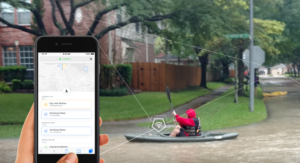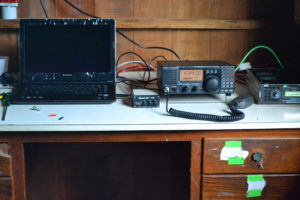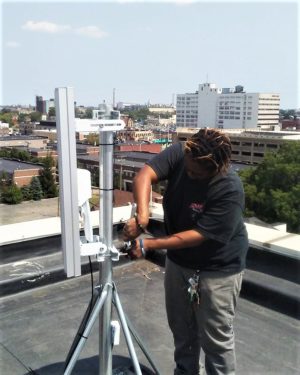The National Science Foundation and Mozilla are supporting projects that keep the web accessible, decentralized, and resilient
Last year, the National Science Foundation (NSF) and Mozilla announced the Wireless Innovation for a Networked Society (WINS) challenges: $2 million in prizes for big ideas to connect the unconnected across the U.S.
Today, we’re announcing our first set of winners: 20 bright ideas from Detroit, Cleveland, Albuquerque, New York City, and beyond. The winners are building mesh networks, solar-powered Wi-Fi, and network infrastructure that fits inside a single backpack. Winning projects were developed by veteran researchers, enterprising college students, and everyone in-between.
What do all these projects have in common? They’re affordable, scalable, open-source, and secure.
“Some 34 million Americans — many of them located in rural communities and on tribal lands — lack high-quality Internet access,” says Jim Kurose, Assistant Director of NSF for Computer and Information Science and Engineering (CISE). “By supporting ideas like the ones that have surfaced through the WINS challenges, Internet access could be expanded to potentially millions of Americans, enabling many social and economic opportunities that come with connectivity.”
“As the value of being connected to the Internet steadily increases, Americans without affordable access to the net are increasingly excluded from a world of social, educational, and economic possibility,” adds Mozilla Fellow and WINS judge Steve Song. “The 20 projects short-listed are evidence of the potential that now exists for thoughtful, committed citizens to build affordable, scalable, secure communication infrastructure wherever it is needed.”
The 20 Stage 1 winners presented rigorously-researched design concepts and will receive between $10,000 and $60,000 each. Winners were selected by a panel of judges from organizations like Nokia, Columbia University, and the Raspberry Pi Foundation.
Up next: All winning teams — along with 90 other WINS submissions — are now invited to build working prototypes as part of the second stage of the competition. In August, these finalists will provide live demonstrations of their prototypes at an event in Mountain View, CA. Final awards, ranging from $50,000 to $400,000, will be announced in the fall of 2018.
OFF THE GRID INTERNET CHALLENGE WINNERS
When disasters strike, communications networks are among the first pieces of critical infrastructure to overload or fail. These 10 creative ideas being recognized with design prizes leverage both the internet’s decentralized design and current wireless technology to keep people connected to each other — and to vital messaging and mapping services — in the aftermath of earthquakes, hurricanes, and other disasters.

[1] Project Lantern | First Place ($60,000) A Lantern is a keychain-sized device that hosts decentralized web apps with local maps, supply locations, and more. These apps are pushed to Lanterns via long-range radio and Wi-Fi, and then saved offline to browsers for continued use. Lanterns can be distributed by emergency responders and are accessed by citizens through a special-purpose Wi-Fi network supported by the Lanterns. Project by Paper & Equator in New York, NY in collaboration with the Shared Reality Lab at McGill University; learn more.

[2] HERMES | Second Place ($40,000) HERMES (High-frequency Emergency and Rural Multimedia Exchange System) is autonomous network infrastructure. It enables local calling, SMS, and basic OTT messaging, all via equipment that can fit inside two suitcases, using GSM, Software Defined Radio and High-Frequency radio technologies. Project by Rhizomatica.
[3] Emergency LTE | Third Place ($30,000) Emergency LTE is an open-source, solar- and battery-powered cellular base station that functions like an autonomous LTE network. The under-50-pound unit features a local web server with apps that allow emergency broadcasts, maps, messaging, and more. Project lead: Dr. Spencer Sevilla in Seattle, WA.
[4] The Next-Generation, Disaster Relief Mobile Phone Mesh Network | Honorable Mention ($10,000) This project provides a phone-to-phone mesh network that’s always on, even if all other systems are offline. A goTenna Mesh device unlocks connectivity using ISM radio bands, then pairs with Android and iOS phones to provide messaging and mapping, as well as back-haul connectivity when available. Project by goTenna in Brooklyn, NY; see the network map here & learn more.
[5] G.W.N. | Honorable Mention ($10,000) G.W.N. (Gridless Wireless Network) leverages ISM radio bands, Wi-Fi modules, and antennae to provide connectivity. When users connect to these durable 10-pound nodes, they can locate nearby shelters or alert emergency responders. Project lead: Dr. Alan Mickelson in Boulder, CO; learn more.
[6] Wind: Off-Grid Services for Everyday People | Honorable Mention ($10,000) Wind uses Bluetooth, Wi-Fi Direct, and physical infrastructure nodes built from common routers to create a peer-to-peer network. The project also features a decentralized software and content distribution system. By Guardian Project in New York; learn more.
[7] Baculus | Honorable Mention ($10,000) Baculus features a telescoping antennae/flag, a Wi-Fi access point, small computer, GPS transceiver, software defined radio, and battery, all housed inside a rolling backpack. The project provides applications like maps and message boards over an ad-hoc, self-repairing Wi-Fi network. Project Lead: Jonathan Dahan in New York; Design Lead: Ariel Cotton; learn more.
[8] Portable Cell Initiative | Honorable Mention ($10,000) This project deploys a “microcell,” or temporary cell tower, in the aftermath of a disaster. The project uses software defined radio (SDR) and a satellite modem to enable voice calls, SMS, and data services. It also networks with nearby microcells. Project lead: Arpad Kovesdy in Los Angeles, CA; learn more.
[9] Othernet Relief Ecosystem | Honorable Mention ($10,000) Othernet Relief Ecosystem (O.R.E.) is an extension of Dhruv’s Othernet installations in Brooklyn, NY. These installations stem from a long tradition of mesh networking wherein the OpenWRT firmware alongside the B.A.T.M.A.N. protocol run on Ubiquiti hardware to form large-scale local area networks. Each island of connectivity can be connected to each other using point-to-point antennas. A toolset of lightweight applications can live on these networks. Project lead: Dhruv Mehrotra in New York, NY; learn more.
[10] RAVE | Honorable Mention ($10,000) RAVE (Radio-Aware Voice Engine) a push-to-talk mobile application providing high-fidelity audio communication via a peer-to-peer Bluetooth or Wi-Fi connection. Multiple RAVE devices form a multi-hop network capable of extending communication over longer distances. RAVE’s range can be extended via a network of relay nodes. These inexpensive, battery-powered devices automatically set up a mesh network that extends real-time voice and internet access throughout a whole community, and text communication over several miles. Project by Throneless in Washington, D.C.; learn more.
SMART COMMUNITY NETWORKS CHALLENGE WINNERS
Many communities across the U.S. lack reliable internet access. Sometimes commercial providers don’t supply affordable access; sometimes a particular community is too isolated; sometimes the speed and quality of access is too slow. These 10 creative ideas being recognized with design prizes aim to leverage existing infrastructure — physical or network — to provide high-quality wireless connectivity to communities in need.

[11] Equitable Internet Initiative (EII) | First Place ($60,000) EII uses a system of relays to beam wireless broadband from a local ISP to vulnerable neighborhoods. The system includes solar-powered batteries, an intranet with apps, and training so local users can build and maintain the network. By the Detroit Community Technology Project, sponsored by Allied Media Projects in Detroit, MI; learn more.
[12] NoogaNet | Second Place ($40,000) NoogaNet provides wireless access within a defined neighborhood by leveraging utility pole-mounted Wi-Fi nodes, point-to-multipoint millimeter wave, and mesh technologies. The project also includes user training for installing, utilizing, and managing a wireless mesh node. Project by the Enterprise Center in Chattanooga, TN; learn more.
[13] Southern Connected Communities Network | Third Place ($30,000) This project entails a broadband tower — and eventually, series of towers — that can deliver 1-Gbps speeds wirelessly to anyone in a 25-mile radius via public spectrums. The towers will be controlled by community members in rural Appalachia and the South who are currently underserved by major ISPs. Project by the Highlander Research and Education Center in New Market, TN.
[14] Solar Mesh | Honorable Mention ($10,000) This project integrates mesh Wi-Fi access points into solar-powered light poles in order to provide connectivity to low-income households. The bandwidth is provided by TMobile. Project by the San Antonio Housing Authority in TX.
[15] Connect the Unconnected | Honorable Mention ($10,000) Using a fixed wireless backbone network, this project provides public housing and homeless shelter residents in a two-square-mile radius with connectivity at speeds up to 35 Mb/s using point-to-point and point-to-multipoint millimeter wave technology. Residents also receive digital literacy training on refurbished devices that they are permitted to keep upon graduation. Project by DigitalC in Cleveland, OH.
[16] Repairable Community Cellular Networks | Honorable Mention ($10,000) This project equips residents with sensors and software to carry out basic repairs and precautionary measures on OpenCellular base stations. The goal: decrease the likelihood and duration of service interruptions. Project by University of Washington in Seattle; learn more.
[17] People’s Open Network | Honorable Mention ($10,000) The People’s Open Network uses off-the-shelf multiband Wi-Fi hardware and custom open-source software to connect and automatically route internet traffic from apartment to apartment and house to house in a decentralized manner. Project by sudomesh in Oakland, CA; learn more.
[18] BarelasGig | Honorable Mention ($10,000) This project uses modern millimeter wave (mmW) technology to provide wireless gigabit backhaul and last-mile connectivity at a fraction of the cost of full fiber deployment. Project lead: Michael Sanchez in Albuquerque, NM.
[19] NYC Mesh Community Network | Honorable Mention ($10,000) This project uses high-bandwidth sector antennas, internet exchange points, mesh protocols, and solar batteries to create a community-owned, decentralized network. Project by NYC Mesh in New York City, NY; learn more.
[20] Telehub 2.0 - DuBois MAN | Honorable Mention ($10,000) This project provides wireless connectivity to underserved neighborhoods and school districts through radio infrastructure mounted on light poles. The project also features educational-technology initiatives to improve academic performance. Project by W.E.B. DuBois Learning Center in Kansas City, MO; learn more.



